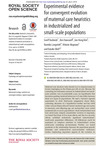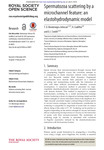Học liệu mở OER: Recent submissions
Now showing items 281-300 of 933
-
Experimental evidence for convergent evolution of maternal care heuristics in industrialized and small-scale populations
(2015)Maternal care decision rules should evolve responsiveness to factors impinging on the fitness pay-offs of care. Because the caretaking environments common in industrialized and small-scale societies vary in predictable ... -
Back to Tanganyika
(2015)The species flocks of cichlid fishes in the East African Great Lakes are the largest vertebrate adaptive radiations in the world and illustrious textbook examples of convergent evolution between independent species ... -
New evidence on the tool assisted hunting exhibited by chimpanzees
(2015)For anthropologists, meat eating by primates like chimpanzees (Pan troglodytes) warrants examination given the emphasis on hunting in human evolutionary history. As referential models, apes provide insight into the evolution ... -
Ectoparasitism shortens the breeding season in a colonial bird
(2015)When blood-feeding parasites increase seasonally, their deleterious effects may prevent some host species, especially those living in large groups where parasites are numerous, from reproducing later in the summer. Yet the ... -
Predicting chemoinsensitivity in breast cancer with omics digital pathology data fusion
(2016)Predicting response to treatment and disease-specific deaths are key tasks in cancer research yet there is a lack of methodologies to achieve these. Large-scale ’omics and digital pathology technologies have led to the ... -
Depth specialization in mesophotic corals and associated algal symbionts in Hawai‘i
(2015)Corals at the lower limits of mesophotic habitats are likely to have unique photosynthetic adaptations that allow them to persist and dominate in these extreme low light ecosystems. We examined the host–symbiont relationships ... -
Spectral analysis of pair correlation bandwidth
(2015)Images from cell biology experiments often indicate the presence of cell clustering, which can provide insight into the mechanisms driving the collective cell behaviour. Pair-correlation functions provide quantitative ... -
Highly contrasted responses of Mediterranean octocorals to climate change along a depth gradient
(2015)Climate change has a strong impact on marine ecosystems, including temperate species. Analysing the diversity of thermotolerance levels within species along with their genetic structure enables a better understanding of ... -
Spermatozoa scattering by a microchannel feature
(2015)Sperm traverse their microenvironment through viscous fluid by propagating flagellar waves the waveform emerges as a consequence of elastic structure, internal active moments and low Reynolds number fluid dynamics. Engineered ... -
Can differential nutrient extraction explain property variations in a predatory trap?
(2015)Predators exhibit flexible foraging to facilitate taking prey that offer important nutrients. Because trap-building predators have limited control over the prey they encounter, differential nutrient extraction and trap ... -
Silver spoon effects on plumage quality in a passerine bird
(2015)A silver spoon effect means that individuals who develop under favourable circumstances enjoy a fitness or performance advantage later in life. While there is large empirical support for silver spoon effects acting on ... -
The duality of spatial death birth and birth death processes and limitations of the isothermal theorem
(2015)Evolutionary models on graphs, as an extension of the Moran process, have two major implementations: birth–death (BD) models (or the invasion process) and death–birth (DB) models (or voter models). The isothermal theorem ... -
Mechanical analysis of avian feet
(2015)The grasping capability of birds’ feet is a hallmark of their evolution, but the mechanics of avian foot function are not well understood. Two evolutionary trends that contribute to the mechanical complexity of the avian ... -
A spectacular new species of seadragon
(2015)The exploration of Earth’s biodiversity is an exciting and ongoing endeavour. Here, we report a new species of seadragon from Western Australia with substantial morphological and genetic differences to the only two other ... -
Isothermal pumping analysis for high-altitude tethered balloons
(2015)High-altitude tethered balloons have potential applications in communications, surveillance, meteorological observations and climate engineering. To maintain balloon buoyancy, power fuel cells and perturb atmospheric ... -
Extreme ecological response of a seabird community to unprecedented sea ice cover
(2015)Climate change has been predicted to reduce Antarctic sea ice but, instead, sea ice surrounding Antarctica has expanded over the past 30 years, albeit with contrasted regional changes. Here we report a recent extreme event ... -
How the zebra got its stripes
(2015)The adaptive significance of zebra stripes has thus far eluded understanding. Many explanations have been suggested, including social cohesion, thermoregulation, predation evasion and avoidance of biting flies. Identifying ... -
Phenotypic assortment in wild primate networks
(2015)Individuals’ access to social information can depend on their social network. Homophily—a preference to associate with similar phenotypes—may cause assortment within social networks that could preclude information transfer ... -
Photothermal raster image correlation spectroscopy of gold nanoparticles in solution and on live cells
(2015)Raster image correlation spectroscopy (RICS) measures the diffusion of fluorescently labelled molecules from stacks of confocal microscopy images by analysing correlations within the image. RICS enables the observation of ... -
The development of a segment based musculoskeletal model of the lower limb
(2015)Traditional approaches to the biomechanical analysis of movement are joint-based that is the mechanics of the body are described in terms of the forces and moments acting at the joints, and that muscular forces are considered ...




















